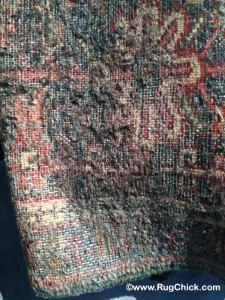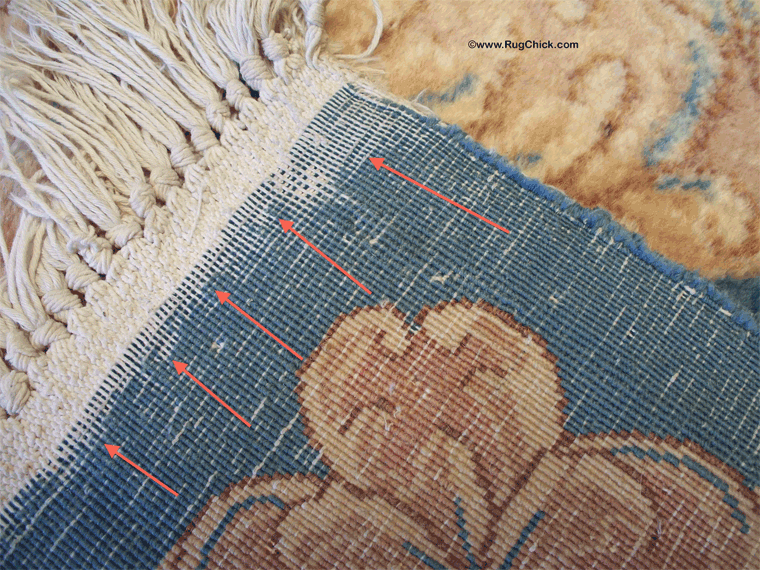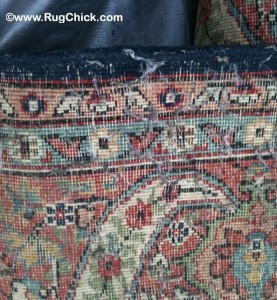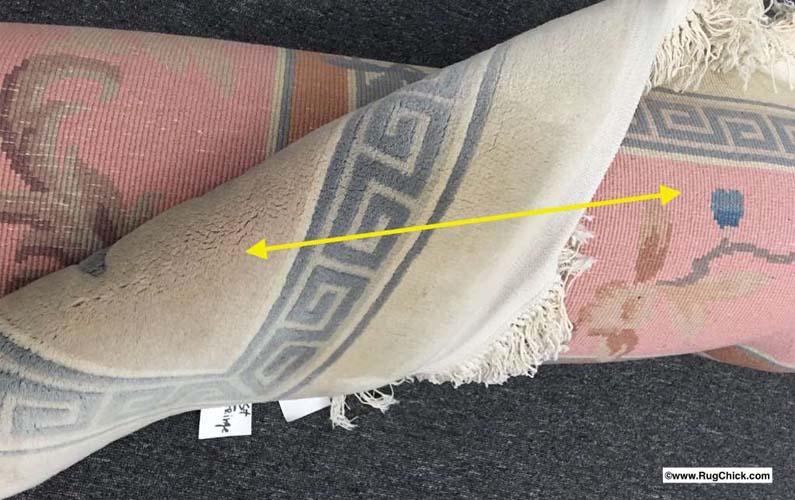Bugs, Rugs, and Storage. What You Need To Know
We’ve recently had several orders with some serious bug problems.
Some were rugs that were improperly stored by their owners for years and made a meal for bugs that, unbeknownst to the owners, had hitched a ride to the storage unit.

Total moth devastation. Most of the knots of the rug were eaten away in storage.
Others were rugs that have been down on the floor for years without being moved or vacuumed, and moths and carpet beetles made a meal in undisturbed areas under furniture.

End of rug under a sofa became a meal for carpet beetles.
Because there does not seem to be a website that clearly lays out how to handle bug infested rugs, or even how to properly store rugs, (a Google search just sent me back to a few posts I’ve made in the past on these subjects) I thought I’d lay out a “how to” post that I hope will be useful to rug cleaners and rug owners.
As a disclaimer – (as you know everyone from litigious California is highly skilled in disclaimers!) – I am NOT a pest control specialist. I am a rug specialist.
These tips are what we’ve learned over the years, and what we’ve experienced in handling a number of wool rugs in storage to see how to keep them safe over years. If you require more in-depth education on specifically killing pests, then please reach out to a pest control professional.
(Here was one page I found on getting rid of carpet beetles that might be useful to you. It is ultimately a sales pitch for their products, but it still has some good data on the little buggers. I’m always wary when anyone says their product is “completely safe” while it also kills things… so take everything with a grain of salt.)
Okay, here we go!
RUG STORAGE TIPS
If you are placing a rug into storage, here are the preparation guidelines for proper care of the textiles if they are natural fiber (wool, silk, cotton).
1. Wash the rug thoroughly.
Washing not only removes potential bug hitchhikers in the rug fibers, but it removes all of the soil and contaminants from the foundation fibers of the rug as well. Compacted, ground in soil in a rug over time can dry out cotton foundation warps and wefts in a rug and lead to dry rot.
If you’ve ever seen an old rug that can crack in some areas when you roll it, then you know what dry rot looks like when caused from too much soil in the base or past improper cleaning (by carpet cleaning machines surface cleaning them instead of true rug washing) that has left too much soapy residue in the fibers. This is one of the reasons why rugs are never cleaned in the home.
A proper rug washing facility will also have “insect repellents” that can be used as a final application on the rug, front and back, that will leave the rug “not tasty” to bugs so they will go elsewhere. At our facility we use Repel by Masterblend, which is approved for use on wool and also approved for use in California. Other states will have access to many more choices than we do in our hyper-sensitive state.
2. Roll and wrap in Tyvek paper.
Folding rugs is something you will see done in many rug galleries in order to conserve space, but can cause undue stress on the foundation fibers of rugs over time. (You can lessen this stress by folding the rugs with the fuzzy pile OUTWARD which allows the foundation fibers to bend less, but it also gets the rugs dusty easier so I rarely see it done this way.)
Ideally rugs should be completely cleaned, insect repelled, and then rolled for long term storage. You roll the rug from the bottom end first to create a tight roll.
(To know which end is the bottom end, pet your rug and see which direction when you pet is going WITH the nap, and which is going AGAINST it. When you are petting WITH the grain it takes you to the bottom end. This is the end where the weaving began. Roll from this end.)
With silk rugs, or more fragile older wool rugs, you can roll the rug with the pile pointing outward to allow for less strain on the foundation. Also big shaggy rugs roll tighter with the long shaggy fibers pointing outward as well.
Most rugs can be safely rolled normally with pile inward. Then you need to wrap the rug in PAPER, not plastic.
Some people use brown Kraft paper. To me that punctures too easily and tears, and with rodents that might be too easy a target. We use it for short term wrapping, but not long term storage.
We like to use Tyvek paper for long term storage which is tear resistant, water resistant, but also still allows the rug to “breathe,” unlike plastic wrap which does not.

Wrap natural fiber rugs in PAPER – either brown kraft or white tyvek.
Wool and plastic should NEVER be combined in storage. Wool has a natural high moisture content (this is why it is flame resistant, it self-extinguishes with flame), so this means if wrapped in plastic and with no airflow, the fibers can “sweat” and create a problem in storage.
If you have ever gotten a rug out from storage that smelled musty and moldy, this is why. Improperly wrapping wool rugs in plastic can create odor problems, or worse, actual mildew problems if the rug was not properly cleaned and then not placed in a climate controlled storage area.
3. Elevate when storing. Don’t stack heavy items on top of them.
Keeping rugs off the floor allows you to easily see if there are any potential problems with rodents more easily in a storage unit, and since storage facilities seems to often be built in low lying regions, if there are floods keeping the rugs elevated can keep them safer. Not stacking heavy items on top of them can keep strain from causing foundation damage to the rug.
4. Check the rug annually.
If possible, check your rugs in storage once a year to make sure the packaging is secure. If the rug was professionally cleaned, and the insect repellent applied, you can extend your check up of opening up the rug packaging, but it may need to be reapplied after 2 or 3 years.
If you have used Tyvek paper it can be unwrapped and the same paper reused because it is tear resistant. Clear packing tape works best with the Tyvek paper.
THIS RUG HAS BUGS! (What do I do?)
If you are a professional cleaner and a client’s rug that they improperly stored has become infested with moths or carpet beetles, or it has been on the floor unmoved for too long and is being eaten away, here are the steps to take.
1. Evaluate the damage, make a decision, and get a waiver.
Sometimes the damage – especially from a rug storage infestation where bugs have been left alone for years to feast on rug fibers – is too great. You have to weigh the costs of cleaning if the rug is not salvageable.
Do NOT inspect rugs with large active infestations inside your facility, take them outside to inspect. The last thing your business needs is bugs finding their way into your cleaning facility. The best next step for an infested rug would be to send the owner to a pest control company to have the rug fumigated, or treated with the appropriate insecticide, to kill the insects before the rug comes to you for cleaning. Reputable licensed pest control companies will provide a certificate of their service, with a guarantee.
If disposal is the only option, refuse to take the rug into your facility. Have the owner write on the work order, or by email if the owner is not at your location, to properly dispose of the contaminated rug.
Sometimes the infestation is concentrated on one area and there could be a possibility of either reweaving lost fibers, or perhaps cutting the rug to make it smaller but still usable.

You need to weigh the cost of reweaving, patching, reducing, or simply disposal. This is damage from a rug placed under a heavy chest and left undisturbed.
If that is the case, that the owner wants the rug “saved” and the area of contamination is small and isolated, then have the affected area treated first by a pest control company and then plan to wash the rug. Afterwards evaluate for repair options.
Often the washing will release more wool knots and create “bald” areas in the rug, so make a note on the invoice of the potential additional visible damage, and photograph the rug to show its state when it came in. (Best to photograph outside so you are not knocking moth larvae or worms into your facility.)
It needs to be clearly understood that any additional damage occurring from washing you cannot possibly be held responsible for. Most bugs eat from the innermost fibers outward, so a cleaner cannot know what the rug can take.
If the rug is woven on a wool foundation (like the prior rug photo) then the damage is complete holes because the bugs eat the wool face fibers AND the foundation warps and wefts.
Many rugs are woven on cotton foundations, so the bugs just eat the wool fibers and the cotton is left in tact, and the rug structurally sound, just looking bald

Kashan rug moth damage under a chair, bugs ate the wool but left the white cotton warps and the gray cotton wefts alone.
Sometimes the damage is only visible on the back, but with the actual back of these knots gone, it is possible that the front fibers will pull loose and wash away, even if you are very gentle with your cleaning.

Kerman rug back corner eaten by bugs. Blue knots are gone from the back, with cotton foundation visible. These areas may become bald on the front as well after the cleaning.
2. Remove what you can. Protect other contents.
Bringing an infested rug into your rug cleaning facility is a danger, so you need to control the situation. Ideally the rug has been treated by a pest control company, and then you can feel safe when bringing this rug inside.
Wool eating bugs do NOT like direct sunlight or persistent airflow. This is why they attack rugs in storage, or in a home they like to make their meal in clothes in a dark undisturbed coat closet, or eating the corner of the rug under the sofa or behind the drapes.
They also find rugs up on walls as hangings tasty if they are never taken down for regular dusting.
If the rug coming into your facility has very minor bug activity, just a few visible moth casings or larvae worms, then take the rug outside into direct sunlight.

Moderate moth activity in one section on the back of this rug. Moth casings/cocoons look like “sticky lint” – they have not made a meal of this rug yet.
Both the larvae and the worms are fragile, and setting them in a few hours of sunlight (both sides of the rug) can often be all you need to protect the situation. Take a stiff bristle brush and brush away the larvae and worms (outside) from both sides of the rug to physically remove them. Topical consumer bug sprays can also be used in these small areas on both sides as added protection.
If the damage is more extensive then you need to take more aggressive measures.

Serious bug activity, the rug needs to be contained.
The first choice is to contact a pest control specialist, because they have the solutions to treat the problem. However, some companies may not apply their solutions to a valuable rug if they are worried about possible risks to the textiles. In order to protect your facility, have the rug client place their infested rug in a heavy plastic bag, and place a lot of mothballs inside the rug as it is rolled up inside the bag. Seal it tight.
Moth ball fumes are toxic, so advise them (or yourself if you are doing this in your facility) to take care to wear gloves and other appropriate protection. These can be purchased at your local drugstore. You need the toxicity of the fumes of the moth balls or crystals to get high enough inside the bag to essentially kill the bugs inside. I would suggest several week sealed, longer if you feel it is necessary.
When the time is up, take special care when opening the bag so that you do NOT breathe the air coming from the bag. Ideally do this outside in a very well ventilated area. Remove the rug in a protected area (or outside) with protective safety gear on, and brush away the larvae and worms – which should not be moving anymore – get them away from the rug as much as you can outside. You might do this over a protective tarp or sheet of plastic so that you can have easy clean up.
3. Treat with approved products and fully wash.
Check your state to see which carpet and rug products are approved for use in removing bugs like carpet beetles, moths, fleas, or even bed bugs for that matter. I really like the Microban line of products for this, all approved by the EPA and approved for use on textiles, but unfortunately not approved by California’s EPA so we cannot use some of them in our state. I’ve used several in my out of state training workshops though, with great success.
Go to your local professional cleaning supply house to see what is available to you. (These are professional cleaning products and are not available to consumers.)
Ideally you will wash the rug and apply the approved product as directed to ensure that any eggs or other bugs hidden deep inside the rug cannot come back to create a problem for the rug in the future, especially if it is going back into storage.
Because we are limited with our choices in CA, we like to soak the rug in a strong vinegar mix, wash thoroughly, and then give a final application of the Repel product mentioned before. I like Repel because it does not smell like mothballs, and it is not a pesticide but a repellent. It essentially “sours” the fibers so that bugs do not find it edible and they look elsewhere for a meal.
With investment or antique textiles where the application of “chemicals” that leave any residue is not wanted, pests are handled by placing them in a subzero deep freezer to essentially “crack” the eggs (which can lay dormant for years until conditions are more favorable) and ensure all bugs are dead.
Not everyone has access to a deep freeze freezer, especially for larger rugs, but that is your other option.
Other companies now also promote high heat to do the same. Those may be the two best options for those who want a non-poison option.
4. Treat and clean the home BEFORE the rugs are returned.
If the infestation occurred with a rug being used in the home, then there are bugs back home to be taken care of. This is especially true of carpet beetles, which though they eat wool, they are often found in furniture and then spread to the rugs.
If the rug owner truly does not want to risk more damage to their rug, then they need to clean the home before it is returned back. A pest control professional should come in to treat all surfaces, and once all bugs are killed off, follow up with a professional cleaning company to remove any of the pesticide residues.
I know many say they are “safe” pesticides, but why even take the risk. I would suggest, as my own personal opinion, to clean after the pest control efforts anyway whether it is sprayed on or fumigated.
Floors, furniture, fabrics, carpeting – it all needs to be cleaned.
5. Quarterly textile inspection. (DUST and DISTURB!)
Rugs should be regularly vacuumed to prevent dust and grit from working its way into the foundation of a rug. Weekly (or every other week) vacuuming is a must for rugs under consistent foot traffic. You do not need a heavy beater bar vacuum, you just want to “lift up” the settling dust that gets on the tips (the same dust that settled on your hard floors and needs to be swept up weekly). Just a quick “sweeping” of the tops of the fibers is all you need.
For tips on how to vacuum properly, read my blog on that topic => How to vacuum my rugs.
Quarterly rug owners should be more invasive with their dusting, and with the upholstery attachment on their vacuum – or if they have a canister vacuum – pull back the corners of rugs and vacuum the floor underneath and the back of the rug corners very thoroughly. Moth larvae can look like sticky lint, so it is easy to miss it under the rug.
Carpet beetles and moths like to settle around the edges of rugs, and usually will eat from the backside of the rug where it’s dark and undisturbed.
A quarterly “dust and disturb” routine will keep them from finding the rug a nice place to sit and eat. They want to place their eggs in a safe spot to have a meal as they move from cocoon to their larvae worm phase.
If you disturb them, they will move somewhere else.
Rugs under regular foot traffic should be washed every 18-24 months. If the foot traffic is heavy (or there are continual pets and kids on the rug) then once a year is recommended. If the rug gets light or no traffic and is regularly vacuumed, then closer to 3 years is not unreasonable.
Rugs that are regularly washed rarely have bug problems, because nothing is more DISTURBING to bugs than having the rug rolled up and taken on a trip for a full service wash.
I hope you find these tips useful, and please let me know in the comments if you have any more questions.
Happy Rug Cleaning!
– Lisa










